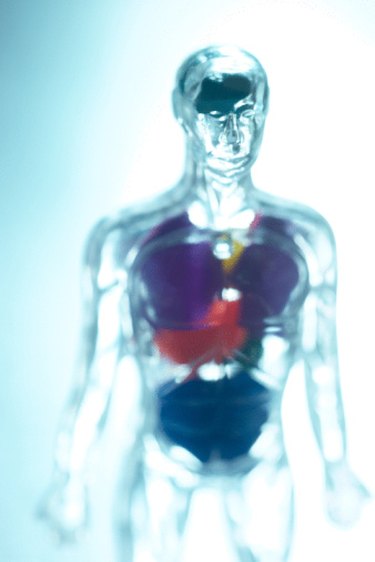
A critical electrolyte in your body is potassium. A positively charged ion, potassium is responsible for electrical relaxation of your muscle cells, especially those in your heart. According to "Harrison's Principles of Internal Medicine," potassium levels are regulated by a number of systems, including aldosterone levels, serum pH and most importantly by kidney function. Rashes and high potassium levels can indicate certain kidney disorders that affect not only your renal function, but also your skin.
Kidney and Potassium Levels
Video of the Day

"Cecil Medicine" says the part of your kidney that reabsorbs potassium is the renal proximal tubule. Proximal tubules represent just a small part of the working units of your kidneys called nephrons. The reabsorption of potassium done in the proximal tubules is performed in conjunction with the reabsorption of water and sodium. Potassium is normally secreted in the distal convoluted tubule of the nephron to maintain proper balance.
Video of the Day
In renal failure, the kidney's ability to filter potassium decreases substantially, causing an increase of potassium levels in the blood, according to "Brenner and Rector's The Kidney." Certain conditions cause renal dysfunction, thus high levels of potassium, as well as rashes on your shins and forearms. These conditions include Henoch-Schonlein purpura, allergic interstitial nephritis and transfusion reaction.
Henoch-Schonlein Purpura
"Nelson Textbook of Pediatrics" describes Henoch-Schonlein purpura nephritis as a vasculitis condition characterized by purple to red spots called purpura on the forearms and shins, abdominal pain, joint pain and kidney dysfunction. Henoch-Schonlein purpura is common in children, presenting one to three weeks after an upper respiratory infection. Immunoglobins deposit in the mesangium of the kidney, causing acute failure and increase of potassium levels in the blood.
Allergic Interstital Nephritis
"Cecil Medicine" describes allergic interstitial nephritis as a hypersensitivity reaction to medications such as antibiotics and nonsteroidal anti-inflammatory drugs. A maculopapular rash appears, especially on your arms and shins, and blood in your urine within one to three days after taking the offending drug. You may experience lower-back pain because of expansion of your renal capsules. Your potassium levels increase resulting from renal tubular defects.
Transfusion Reaction
Transfusion reactions occur when you are given blood not compatible with your own, according to "Harrison's Principles of Internal Medicine." Incompatible blood causes a hypersensitivity reaction by your immune system, resulting in hemolysis, or destruction of your blood cells. This reaction produces a hemolytic rash and kidney failure. As with all kidney dysfunction, potassium levels increase and lead to dangerous arrhythmias, or abnormal heart beat, and even death.
Treatment
"Cecil Medicine" indicates the treatment of allergic interstitial nephritis includes removing the offending drug as well as giving corticosteroids, such as prednisone, along with cyclophosphamide.
Henoch-Schonlein purpura is a self-limiting condition that usually resolves on its own. In more severe cases, prednisone and cyclophosphamide are given, according to "Nelson Textbook of Pediatrics."
"Harrison's Principles of Internal Medicine" notes transfusion reaction is treated with prednisone, antihistamines and intravenous fluid. Prevention involves typing your blood and testing it for cross matching.